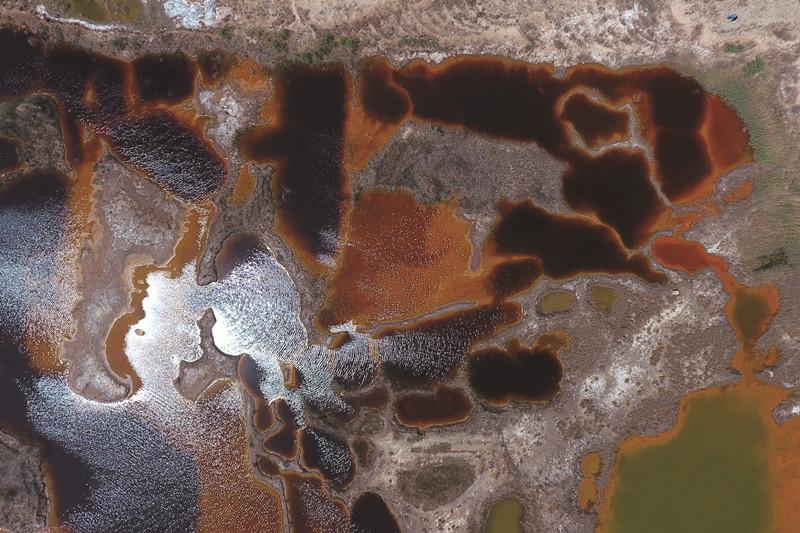
 Old Version
Old Version
Fetid Pools
On April 18, 2017, photos of a cluster of red and yellow pools of polluted water around a village in Dacheng County, Hebei Province, went viral online after being released by an environmental protection NGO. The largest pit had a surface area of more than 170,000 square meters of industrial waste, equal to 24 standard soccer pitches.
On April 19, the Ministry of Environmental Protection made an announcement to confirm the pollution and pledged to launch a joint investigation. Three days later, Tian Weiyong, head of the Environmental Inspection Bureau under the ministry, said the pools were the result of the illegal discharge of industrial pollutants and the government will “crack down on the act at the national level and show no tolerance to such incidents.”
Authorities later disclosed that the biggest dumping pit in Nanzhaofu Village, Dacheng County, around 130km south of Beijing, was located at a former brick-making plant built in 1982 that ceased production in 2016. Another pit in the village, covering 30,000 square meters, had been home to a chemical fertilizer plant.
Visiting the area, a NewsChina reporter found that pits of various sizes were scattered across the village like scars, occupying a third of the arable land in the village. “The villagers are strongly opposed to the brick-making plant because it destroyed our hometown,” a villager told our reporter on condition of anonymity.
On April 20, Li Ming (pseudonym), a technician from the Hebei Prospecting Institute of Hydrology and Geology, was tasked with undertaking an emergency survey of the dumping pool pollution at Nanzhaofu Village. Together with seven colleagues, Li took two sonar surveying ships and equipment to the village to calculate the volume of polluted water.
Arriving at the scene, Li was taken off guard as the pollution was far worse than he had expected. The pit was two kilometers away from a main road, surrounded by strips of derelict farmland where not even a blade of grass was growing. The bank of the pit was rust brown with a pungent smell of industrial waste.
“The location was an easy option for the illegal dumping of acidic waste and materials laced with heavy metals. The PH level of the water inside was 2.1, which means the dump pit was strongly acidic,” Li told NewsChina.
According to the local authority, the acid waste was initially discharged into the pit by two villagers from 2011 to 2012. In March 2013, they were arrested after tip-offs from locals, confirming that at least 6.1 tons of acid had been dumped into the pit.
Xu Junqiang, a local villager, told our reporter that he was a worker at the brick-making plant in 2010 and nobody came to discharge industrial acid then. After 2012, however, it became an open secret in the village that the site was being used for the illegal dumping of acid. “Villagers sometimes encountered trucks heading to the brick-making plant and the vehicle plates were registered in the province. It cost roughly 10,000 yuan (US$1,450) to discharge 30 tons of industrial waste into the pit,” he said.
According to market values, however, it costs roughly 3,000 yuan (US$435) to treat just one ton of industrial waste water. It is not rare in Hebei Province to illegally discharge waste water and official statistics from China Judgments Online showed that from August 2013 to March 2017, 1,369 judgments related to pit dumping were ruled nationwide, including 433 cases handled by courts in Hebei Province, accounting for nearly a third of the total number.
“After the two villagers were arrested, the illegal discharge of chemical waste water remained rampant and we have been detaining offenders regularly ever since,” Rong Li, chief environmental inspector of the Hebei Environmental Protection Bureau, told NewsChina. He added that Hebei’s Public Security Bureau even hired private environmental inspectors to tighten management in the production, transportation and treatment of dangerous waste water. What’s more, local villagers organized themselves to protect the village from illegal waste dumping.
The dumping pits have seriously affected the lives of local villagers. Xu Junqiang said the brick-making plant used to discharge waste water into the Baima River. Villagers irrigated crops with the river water but after the river was polluted, crops soon perished. Locals were also worried about the safety of ground water and no longer dared to drink well water.
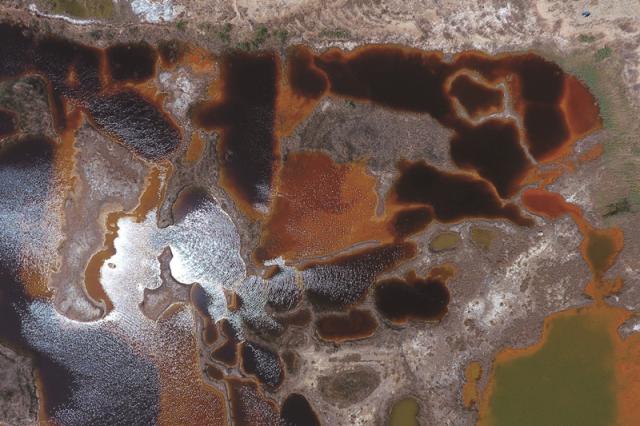
View of a pit of about 170,000 square meters of waste, Nanzhaofu Village, Langfang City, Hebei Province, April 20, 2017
A villager told our reporter that the illegal dumping of acid had become a business for many people in the village and as long as money was paid, anyone could show the way for vehicles to dump liquid waste. The business began to attract government attention in recent years.
According to a report provided by the Dacheng County government, the local government partnered with an environment company to treat the polluted pit at the brick-making plant in March, 2014. Meanwhile, OriginWater, another company specializing in the treatment of water pollution, was contracted to bring the water quality at the chemical fertilizer plant back up to standard.
The first round of treatment at the chemical fertilizer plant pool started in April and lasted till the end of July 2014. The local government paid a total of 150,000 yuan (US$21,800) as a deposit. Before that, Wang Weihua, general manager of OriginWater made a field trip to the pit. He recounted that the acidic water in the pit was dark green with a pungent smell and that the main pollutants were acid, heavy metals and phosphorus.
The company’s main treatment method was adding calcinated lime to the pit. After the treatment, the county environment watchdog carried out an inspection and issued an acceptance report. By the end of August, 2014, however, the water quality had deteriorated. After the second round of treatment and a further investment of 100,000 yuan (US$14,500) in November 2015, the water quality further deteriorated starting from September 2016. During media interviews, OriginWater’s Wang said his company offered to provide a further treatment plan but was turned down by the government.
Xu Junqiang told our reporter that the technician responsible for the treatment was dismissed by the company when the treatment was under way and the remaining work was finished by him and another villager. “We worked as ordered by [OriginWater]. The company did not treat pollution seriously and they just wanted to cheat the government for money. We have been working for three years and during the period it’s been pretty much one day on, two days off,” he said.
“[OriginWater] failed to thoroughly figure out where the pollution came from and what the state of water quality was at the time,” Peng Yingdeng, an expert at the Beijing Municipal Research Institute of Environmental Protection, told Beijing News. Peng added that an overall examination is a precondition for the government to be able to develop procedures for dealing with the pollution, as restoring water and soil quality is both costly and time-consuming.
Sun Shaojin, deputy party chief of Dacheng County, said the brick-making plant was the main culprit. He said the plant was the first enterprise in the village and the government provided farmland extracting the material for making the bricks, leaving numerous pits. Since the 1990s, companies that produced heavy pollution had sprang up in the village and the pits became the perfect dumping grounds for industrial waste water.
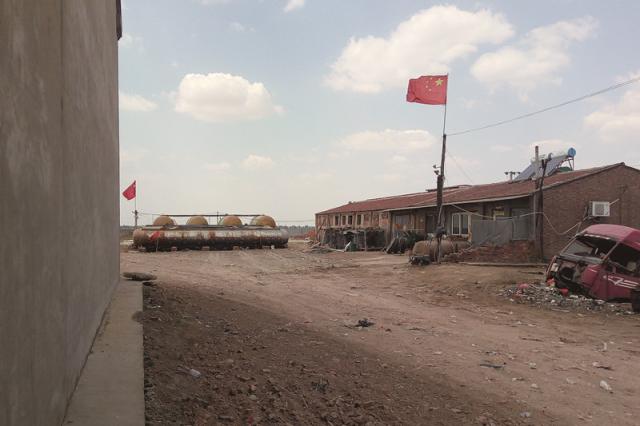
A yard with a number of containers at Maliulang Village, Dacheng County, Hebei Province, which villagers said was an acid plant, April 2017
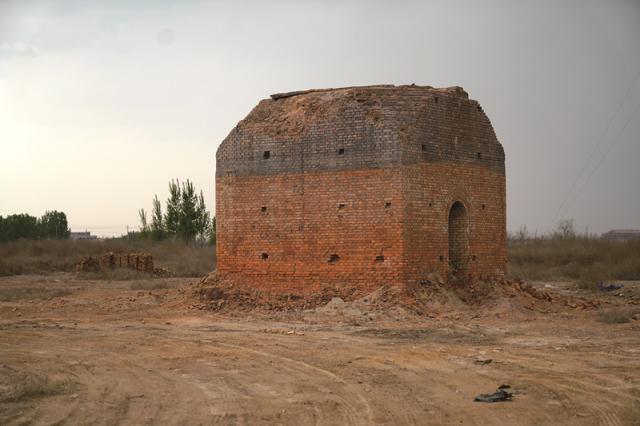
Villagers of Nanzhaofu Village, Hebei Province, pooled money to build brick factories. The pits that resulted are still there, April 20, 2017
Over the years, dealing with sewage pits and dry well dumping has been a key task for Hebei’s provincial environmental protection agency. During an inspection of polluted ground water in northern China in 2013, the Ministry of Environmental Protection found that 55 enterprises had illegally discharged industrial water into sewage pits, ponds and irrigation channels. In the same year, Hebei’s environmental protection department punished 38 enterprises in the province which had illicitly discharged polluted water.
After the media reports of the dumping pits in Dacheng County broke, Wen’an County, 50 kilometers away, was busy covering up its pollution. Zhangqingkou Village in the county had been discharging industrial water into dried up wells since 2003 when more than 30 electroplating factories set up in the village.
In April 2017, Wen’an County’s environmental protection department organized a discussion with all 30 electroplating factories on the treatment of pollution. During the meeting, enterprises were asked whether they would like to treat pollution themselves. If they refused, the government would pay for it but shut down all those that failed to meet environmental standards.
Song Fei (pseudonym) has been the manager of an electroplating factory for nearly five years. He has 2,000 square meters of workshop and the products are mainly sold in Tianjin, 90 kilometers away. He said his enterprise discharged 10 tons of industrial water into the dry wells each day on average and none of the enterprises in the village had waste water treatment equipment.
“Most enterprises are manual workshops without a business license. We do not need to pay any taxes as long as the staff at the environment department are satisfied,” he told our reporter.
“After an enterprise is established, the environmental department will arrive and ask you to buy an environmental permit for 900,000 yuan (US$130,000). If you hesitate, the government will regularly come and pick faults and you have to pay more.”
Song said there are four enterprises in the village that have obtained environmental permits, including his, and when a government agency planned to come and inspect them, the environmental department would inform him in advance. Over the past five years, Song has had numerous inspections and each time his business was found to be “up to environmental standards.”
Nevertheless, after the media scrutiny of pollution in Dacheng County and the involvement of the country’s top environmental protection authority, the local government has become increasingly serious in dealing with pollution. “The county head and deputy head visited our village several times recently and the environmental protection department asked us to deal with pollution by ourselves first. We were told if it is not up to standard this time, no enterprise will survive,” he said.
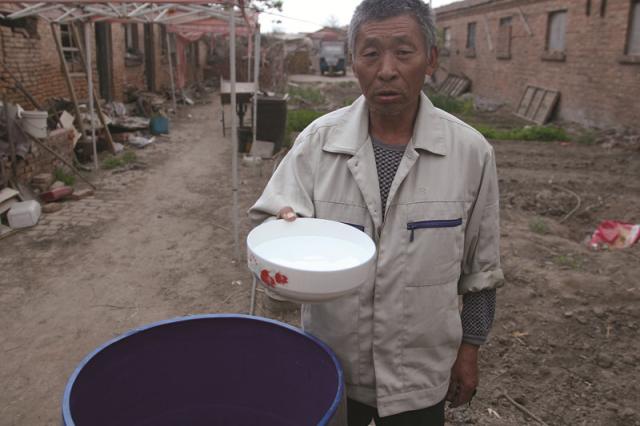
“These acid pits are surrounded by farmland; crops are affected, and groundwater hit most seriously, “ says Ma Jincai of Nanzhaofu Village, Dacheng County, Langfang City, Hebei Province, April 20, 2017